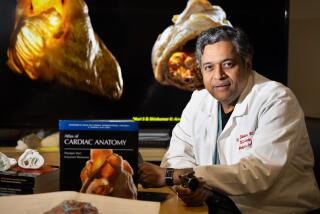Scanning mummies for heart disease ‘about as fun as it can get’
As medical director of the MemorialCare Heart & Vascular Institute at Long Beach Memorial Hospital, preventive cardiologist Dr. Gregory Thomas counsels modern-day patients, urging them to eat right, exercise and quit smoking to keep their hearts healthy.
But for the last five years or so, Thomas and a 19-member “dream team” of cardiologists, anthropologists and radiologists from all over the world have also been spending a lot of time focusing on a different set of patients, long-deceased: mummies.
Traveling from Egypt to Peru to the hallways of great American museums, they have been seeking permission to place the preserved bodies of ancient people in CT scanners to look for evidence of hardened arteries. Their hope is to figure out why it is that so many people today develop the vascular blockages that lead to heart attacks and strokes.
PHOTOS: Scanning ancient mummies, in search of heart disease
“This is about as fun as it can get,” Thomas said in an interview with the Los Angeles Times. “You’re going into the basement of the Egyptian museum and walking through what is essentially an Indiana Jones set. Mummies to the right, mummies to the left, a dirt floor with light bulbs hanging down.”
Ancient and preindustrial people, their explorations have revealed, suffered from cardiovascular disease -- calcifications in the arteries -- just as modern people do today. That’s somewhat puzzling, Thomas said, because unlike us, the Egyptians and Peruvians (as well as native peoples in Alaska and the American Southwest, also scanned by the group) didn’t have access to fast food.
On the contrary, Thomas said, “they’re living off the land -- what we’d think of as the healthiest diet you could eat. And yet they have atherosclerosis too.”
There were reasons other than diet why the ancients might have developed cardiovascular disease. One theory that fascinates the team: that suffering frequent infections might have increased inflammation in their bodies, contributing to the arterial blockages.
The takeaway, Thomas said, isn’t that patients should throw up their hands and give up on living right -- it still helps. Rather, it’s that scientists still have a lot to learn about why humans are predisposed to heart disease.
“We have to go back to the drawing board and look at things differently,” he said.
For the full Los Angeles Times story about the mummy research, click on the top related link, to the left of this post. An abstract of a study describing the mummy research, published in The Lancet on Sunday, is available here.
Follow me on Twitter: @LATerynbrown






